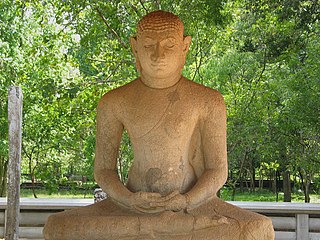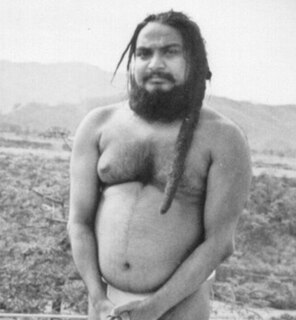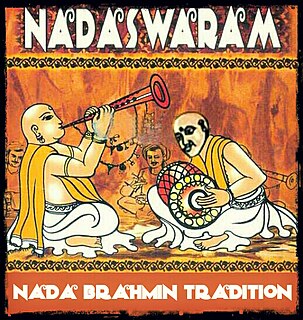
Yoga is a group of physical, mental, and spiritual practices or disciplines that originated in ancient India, aimed at controlling ('yoking') and stilling the mind, and recognizing the detached 'witness-consciousness' as untouched by the activities of the mind (Citta) and mundane suffering (Duḥkha). There are a broad variety of the schools of yoga, practices, and goals in Hinduism, Buddhism, and Jainism, and traditional forms and modern methods of yoga are practiced worldwide.
Ātman is a Sanskrit word that refers to the (universal) Self or self-existent essence of human beings, as distinct from ego (Ahamkara), mind (Citta) and embodied existence (Prakṛti). The term is often translated as soul, but is better translated as "Self," as it solely refers to pure consciousness or witness-consciousness, beyond identification with phenomena. In order to attain moksha (liberation), a human being must acquire self-knowledge.

Samadhi, in Hinduism, Jainism, Buddhism, Sikhism and yogic schools, is a state of meditative consciousness. In the yogic traditions, and the Buddhist commentarial tradition on which the Burmese Vipassana movement and the Thai Forest tradition rely, it is a meditative absorption or trance, attained by the practice of dhyāna. In the oldest Buddhist suttas, on which several contemporary western Theravada teachers rely, it refers to the development of a luminous mind which is equanimous and mindful.

Advaita Vedānta is a school of Hindu philosophy and "spiritual experience." The term Advaita refers to the idea that Brahman alone, pure consciousness, is ultimately real, while the transient phenomenal world is an illusory appearance (maya) of Brahman, and the true self, atman, which is self-luminous pure awareness, is identical with Brahman. In this view, jivanatman or individual self is a mere reflection of singular Atman in a multitude of apparent individual bodies.

The Yoga Sutras of Patañjali is a collection of Sanskrit sutras (aphorisms) on the theory and practice of yoga - 195 sutras and 196 sutras. The Yoga Sutras was compiled in the early centuries CE, by the sage Patanjali in India who synthesized and organized knowledge about yoga from much older traditions.

Kriya Yoga is the active aspect of yoga. The Yoga Sutras of Patanjali 2.1 defines three types of kriya (action):
The yoga of action (kriyayoga) is: asceticism (tapas), recitation (svadhyaya), and devotion (pranidhana) to Ishvara.

Dhyāna in Hinduism means contemplation and meditation. Dhyāna is taken up in Yoga practices, and is a means to samadhi and self-knowledge.

Pranava yoga is meditation on the sacred mantra Om, as outlined in the Upanishads, the Bhagavad Gita, and the Yoga Sutras of Patanjali. It is also called Aum yoga and Aum yoga meditation. It is, simply put, fixing the mind on the sound of the mantra “Aum” – the sacred syllable that both symbolizes and embodies Brahman, the Absolute Reality – as the mantra is constantly repeated in unison with the breath. The purpose of pranava yoga is to become free from suffering and limitation.

The Shrimad Bhagavad Gita, often referred to as the Gita, is a 700-verse Hindu scripture that is part of the epic Mahabharata, dated to the second half of the first millennium BCE and is typical of the Hindu synthesis. It is considered to be one of the holy scriptures for Hinduism.

Jangama dhyana is a meditation technique which has been practiced by various sages over the centuries. In recent times, this technique was widely taught in India and around the world by Shri Shivabalayogi Maharaj, who experienced a spiritual vision in which the manifestation of a Jangama sage instructed him in this technique of meditation to achieve self-realization. Jangama means 'eternal existence' and dhyana means 'meditation.' Hence Jangama dhyana is 'Meditation on the Eternal Existence .'
Uparati, is a Sanskrit word and it literally means "cessation, quietism, stopping worldly action". It is an important concept in Advaita Vedanta pursuit of moksha and refers to the ability to achieve "dispassion", and "discontinuation of religious ceremonies".

Shabda Brahman or Sabda-brahman or Nada brahman means transcendental sound or sound vibration or the transcendental sound of the Vedas or of Vedic scriptures.
Pratibimbavada or the theory of reflection, whose origin can be traced to the Brahma Sutra II.iii.50, is credited to Padmapada, the founder of the Vivarna School of Advaita Vedanta and the author of Pancapadika which is a commentary on Sankara’s Brahma Sutra Bhasya. According to the Vivarna School, Brahman is the locus of Avidya, and which, with regard to the relation existing between the Jiva and Brahman, concludes that the Jiva is a mere reflection (pratibimba) of its prototype (bimba) i.e. of Brahman, and therefore, identical with its essence, Brahman. This school holds the view that the mahavakya, tat tvam asi, is sufficient for the attainment of enlightenment, of the realization of the identity between the self and Reality.
Idam (Tamil) is a Tamil/Sanskrit word which denotes location or position or place. In grammar it is used at the beginning or middle of a sentence as a nominative or attributive pronoun, combined with or without ya, adds emphasis to other nouns, propositions etc.; and means - this, here or yonder, present or seen nearby, fit for, or without reference to noun refers to एतद् ('that') or to what precedes.
Dhṛti or Dhriti or Dhruti, one of the Yamas, means to 'act with determination', 'patience', 'firmness', and refers to 'perseverance', 'wearing regularly' and to one of the eleven Rudranis. There is no correct equivalent English word for Dhrti which is derived from dhr- meaning 'to bear'. Dhrti meaning 'fortitude' and 'determination' is defined as the subtle faculty in man that makes him strive continuously towards a goal. It provides courage, enthusiasm and perseverance to face and overcome all odds and obstacles.
Prajña or Pragya as प्रज्ञा, प्राज्ञ and प्राज्ञा is used to refer to the highest and purest form of wisdom, intelligence and understanding. Pragya is the state of wisdom which is higher than the knowledge obtained by reasoning and inference.
The Upanishadic philosophy of experience expounded by Gaudapada is based on the cryptic references made by the sage of the Mandukya Upanishad to the experience of the individual self of its own apparent manifestations in the three fundamental states of consciousness, and to the Fourth known as Turiya. Turiya is identified with “that goal which all the Vedas declare” - सर्वे वेदा यत् पदमानन्ति, and whose characteristics are not dissimilar to those of the non-dual Brahman.
Samādhāna or samādhānam is a Sanskrit noun derived from the word, samādhā (समाधा), and variously means – putting together, uniting, fixing the mind in abstract contemplation on the true nature of the soul, contemplate oneness, concentrated or formless meditation, commitment, intentness, steadiness, composure, peace of mind, complete concentration, clearing up of doubt or replying to the pūrvapakṣa, agreeing or promising, a leading incident, justification of a statement, proof, reconciliation or eagerness.
Vichāra means deliberation; It is the faculty of discrimination that discerns the Real, Brahman, from the unreal.

Ashtanga yoga is Patanjali's classification of classical yoga, as set out in his Yoga Sutras. He defined the eight limbs as yamas (abstinences), niyama (observances), asana (postures), pranayama (breathing), pratyahara (withdrawal), dharana (concentration), dhyana (meditation) and samadhi (absorption).











